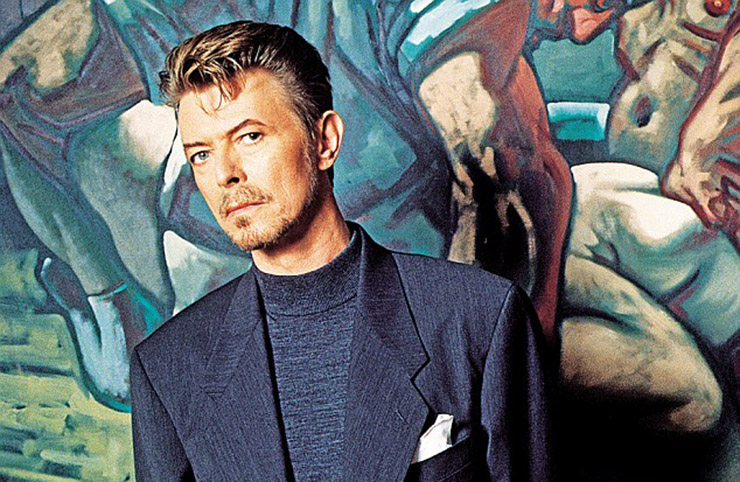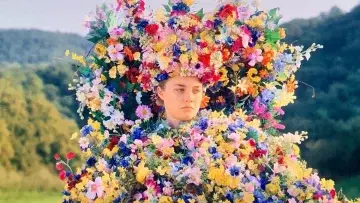A matchless musician who was consistently ahead of the curve, David Bowie bent popular culture to his whim with chameleonic changes in his sound and visual aesthetic, often leading where other acts dared not follow. Renowned for embodying various characters and guises as he genre-hopped throughout the decades of his career, Bowie even remarkably kept the music world guessing right until the very end of his life.
His superb, coded final album Blackstar – released in 2016 on his 69th birthday, only two days before the Starman would return to space – ensured his imprint on popular music would remain, given he virtually wrote the album as his own epitaph.
Whilst his impact on music cannot be overstated, away from the stage and the recording studio, David Bowie loved to paint.
He didn’t just dabble in the art form, however. Bowie was a celebrated neo-expressionist painter, respected by the art community that he himself so admired. Like many actors who claim the theatre is their first love – yes, Bowie was also an established actor – you could say that painting was perhaps his.
An avid art collector throughout his entire life, David Bowie amassed a formidable art collection. Auctioned off by Sotheby’s for $41 million in 2016, his personal collection included originals by Damien Hirst, Jean-Michel Basquiat, and Marcel Duchamp. In one of his earliest interviews, he set his stall, admitting on ITV’s Russell Harty Plus Pop programme in 1973: “I’ve always found that I can collect, I’m a collector,” though he was referring to his insatiable desire to cherry-pick wide-ranging themes and ideas that he could reconstitute into his own music.
But between his day job of extensive touring and recording schedules, he put this notion into practice with painting too and was a dab hand with a paintbrush.
READ MORE: David Bowie is the best-selling vinyl artist of the 21st Century
Studying art and design during his school days at Beckenham Technical School in Bromley, Kent, Bowie – then David Robert Jones – was taught by Peter Frampton’s dad Owen, who he later called “an excellent art teacher and an inspiration” after the highly-regarded teacher died in 2005. Art made way for music – and founding The Society for the Prevention of Cruelty to Long-Haired Men – after Bowie left school, however, and the rest is history.
It wasn’t until Bowie’s move to Berlin that his love affair with painting meaningfully reignited. A period in which fans will know as one of the musician’s most fervently creative and daring, he released his beloved ‘Berlin Trilogy’ of Low and Heroes in 1977 and Lodger in 1979.
But his adoration for German Expressionist art pre-dated his years in the German capital, perhaps partly inspiring his move there and escaping the Los Angeles maelstrom. Iggy Pop, Bowie’s pal who accompanied him in his relocation, provided the subject matter for one of his portraits of the era: Berlin landscape with JO – 1978 (Portrait of Iggy Pop (James Osterberg)).
As Bowie immersed himself into life as a Berliner, the grey, divided city and its inhabitants even made its way into his paintings, notably 1977’s Child In Berlin, a haunting composition of a peculiar child staring up a flight of stairs and directly meeting the artist’s gaze.
Living a heavily drug-addled lifestyle, one that plagued him both personally and professionally in previous years, Berlin offered David Bowie a blank canvas. Whilst he had created his silkscreen Major Arcana tarot card series whilst in Los Angeles, alongside a succession of sketches for projects like his ambitious 1974 Diamond Dogs tour, a new life in a new city with a new passion offered him a focus or meditative venture away from his addiction.
Painting a number of portraits and creating lithographs throughout this fertile period, Bowie may’ve not possessed the technical prowess to be considered a master painter. His use of bold, bloodied tones of colour with unhinged, often disturbing imagery (frequently in self-portraits) suggests his process was a cathartic and necessary one, however, plaintively expressing his artistic influences too.
READ MORE: Basquiat and Warhol: Who Exploited Who?
Very Private Gallery said of his artworks: “David Bowie paintings show a knowledgeable approach to art, influenced by Frank Auerbach, David Bomberg, Francis Bacon, Francis Picabia…,” and that his work “also shows a touch of postmodernism, more precisely neo-expressionism movement.” A fair assessment, and one that he would’ve no doubt welcomed.
Bowie only tentatively previewed his paintings over the years, so the wider music world might not have necessarily been aware of his other life as a painter until his self-portrait was used as the cover art for the 1995 album Outside. Nevertheless, intrigue around his painting continued to flourish throughout the 1980s. He befriended his idol Andy Warhol, as well as key neo-expressionist painters Jean-Michael Basquait and Julian Schnabel – the latter of which directed the 1996 biopic Basquait in which Bowie played Warhol.

Similarly to his music, Bowie, as a painter, continually sought out new inspiration. His varied works include a vibrant portrait of Japanese author Yukio Mishima, the DHead series where he’d paint portraits of friends like American pianist Mike Garson, and his exploration of the “white ancestor” mythology of South African tribes after visiting with his wife, Iman.
David Bowie subtly exhibited his Neo-Expressionist paintings in New Afro/Pagan and Work: 1975-1995 at The Gallery in Cork Street, London, the same year that Outside was released, and was featured at the Daniel Blaise Thorens Gallery in Basel the following year. However, the extent of his life’s paintings was shown posthumously in the V&A’s incredible ‘David Bowie Is’ exhibition.
South African artist and Bowie collaborator Beezy Bailey noted at the time of his initial exhibitions: “He wanted to be thought of as a valid artist. But to be taken seriously as a painter when you are a musical genius is virtually impossible.” An iconoclast in music and in his paintings, David Bowie defied criticism of artists changing lanes, telling the Telegraph in 1996: “I’m determined that if I want to paint, do installations or design costumes, I’ll do it.”
Keep up to date with the best in UK music by following us on Instagram: @whynowworld and on Twitter/X: @whynowworld





